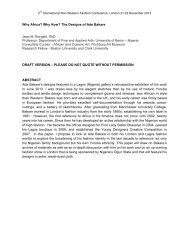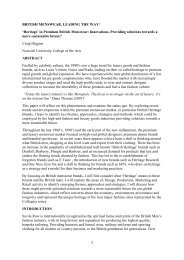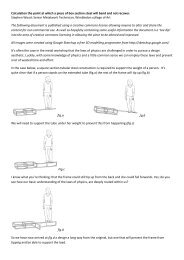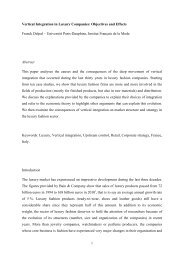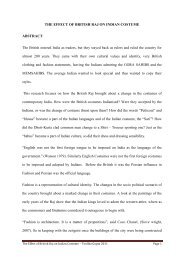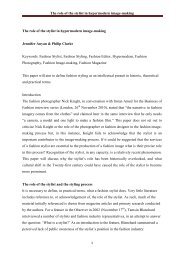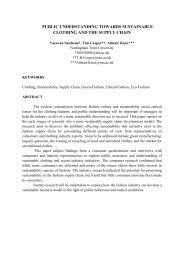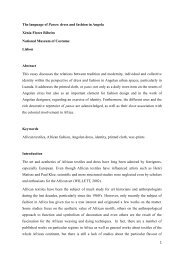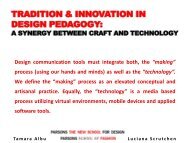1 Abstraction and idealization: the case of Futurist and ... - Arts
1 Abstraction and idealization: the case of Futurist and ... - Arts
1 Abstraction and idealization: the case of Futurist and ... - Arts
Create successful ePaper yourself
Turn your PDF publications into a flip-book with our unique Google optimized e-Paper software.
forms‟. xxxiii Extremely simple geometric shapes, <strong>and</strong> complementary colours, soon became<strong>the</strong> trademark <strong>of</strong> <strong>the</strong> practical, hygienic clo<strong>the</strong>s, designed by Constructivists artists, whichhad to suit <strong>the</strong> structures <strong>of</strong> <strong>the</strong> working life.As a post-WWI development <strong>of</strong> Russian Futurism, Constructivism developed in 1920-1922from a series <strong>of</strong> debates at INHUK, <strong>the</strong> Institute <strong>of</strong> Artistic Culture in Moscow (1920-1924),which culminated in <strong>the</strong> formulation <strong>of</strong> Productivist <strong>the</strong>ory, propounded in particular by OsipBrik. The manifesto <strong>of</strong> Productivism dem<strong>and</strong>ed <strong>the</strong> end <strong>of</strong> <strong>the</strong> easel painting, <strong>and</strong> moregenerally <strong>of</strong> art for art‟s sake, in favor <strong>of</strong> an immediate integration <strong>of</strong> art, life <strong>and</strong> industrialproduction. In <strong>the</strong> article „From easel-painting to <strong>the</strong> printed fabric‟ for <strong>the</strong> journal LEF (LeftFront <strong>of</strong> <strong>the</strong> <strong>Arts</strong>), xxxiv Brik argued: „only those artists who have understood once <strong>and</strong> for allthat work associated with production is not just one art-form among o<strong>the</strong>rs but <strong>the</strong> onlypossible art-form, only <strong>the</strong>y are in a position to find a solution to <strong>the</strong> problems <strong>of</strong>contemporary art‟. xxxvThe artistic production is now conceived in terms <strong>of</strong> consciousness <strong>of</strong> <strong>the</strong> production processitself, <strong>and</strong> <strong>the</strong> vehement „V proizvodstvo!‟ becomes <strong>the</strong> revolutionary motto <strong>of</strong> <strong>the</strong> Russianavant-garde. xxxvi The organic relationship between art <strong>and</strong> industry, <strong>and</strong> <strong>the</strong> edification <strong>of</strong> lifein its material forms, writes Boris Arvatov, is <strong>the</strong> practical program <strong>of</strong> <strong>the</strong>Constructivists. xxxvii Born is <strong>the</strong>n <strong>the</strong> idea <strong>of</strong> an art aiming at <strong>the</strong> restatement <strong>of</strong> new forms <strong>of</strong>life <strong>and</strong> social behaviour, an art that is in close connection with production <strong>and</strong> could reflect<strong>the</strong> structures <strong>of</strong> ordinary life (in Russian „byt‟). This connection is based on <strong>the</strong> identitybetween <strong>the</strong> notion <strong>of</strong> „art‟ <strong>and</strong> that <strong>of</strong> „work‟, postulated by Productivism. xxxviii In <strong>the</strong> postrevolutionaryRussia, art progressively ceases to be an aes<strong>the</strong>tic category <strong>and</strong> is almostidentified with <strong>the</strong> process <strong>of</strong> production. It is <strong>the</strong> refusal <strong>of</strong> an art springing fromcontemplation <strong>and</strong> from those notions <strong>of</strong> „inspiration‟, „genius‟ <strong>and</strong> „creativity‟. The slogansoutlined by Alex<strong>and</strong>er Rodchenko in 1921 indeed sound: „CONSTRUCTION is <strong>the</strong>contemporary requirement for <strong>the</strong> ORGANIZATION <strong>and</strong> utilitarian use <strong>of</strong> material. ACONSTRUCTIVE LIFE IS THE ART OF THE FUTURE. ART which has not entered lifewill be numbered <strong>and</strong> h<strong>and</strong>ed over to <strong>the</strong> archaeological museum <strong>of</strong> ANTIQUITY‟. xxxixConstructivists sharply distinguish between an art that pursues a pure aes<strong>the</strong>tic research froman art that, on <strong>the</strong> contrary, actively participates in that process <strong>of</strong> social evolution <strong>and</strong>transformation inaugurated by <strong>the</strong> October Revolution. Artists as Alex<strong>and</strong>er Rodchenko <strong>and</strong>Varvara Stepanova (Varst), who had previously worked in <strong>the</strong> realm <strong>of</strong> figurative art as well,soon ab<strong>and</strong>oned <strong>the</strong> aes<strong>the</strong>tic „composition‟ to embrace instead <strong>the</strong> „construction‟ following<strong>the</strong> Productivist principles. The demarcation between art, life <strong>and</strong> production thus dissolvesinto <strong>the</strong> program <strong>of</strong> a radical renovation involving any aspect <strong>of</strong> daily life.Within <strong>the</strong> quest for an absolute change, clothing constitutes a fundamental symboliccomponent: <strong>the</strong> objective for <strong>the</strong> Constructivists is in fact to create „production clothing‟(prozodezhda) that is no longer vehicle <strong>of</strong> signs evoking social distinctions, but is ra<strong>the</strong>rpractical, light <strong>and</strong> comfortable. In <strong>the</strong> overalls conceptualized <strong>and</strong> designed by Stepanova,any reference to an individual‟s social role or aes<strong>the</strong>tic preferences is completely absent. In<strong>the</strong> article „Kostjum segodnjasnego dnja-prozodezhda‟ („Present Day Dress – ProductionClothing‟), xl Stepanova explains that <strong>the</strong> worker‟s overall is conceived for a specific socialaction, <strong>and</strong> is diversified depending on <strong>the</strong> mansion <strong>the</strong> worker is called to fulfill.The October Revolution, as remarked by Tat‟jana Strizhenova, contributed to eliminate socialdiscrepancies in <strong>the</strong> way people used to dress, being <strong>the</strong> only differences determined by: <strong>the</strong>pr<strong>of</strong>ession, <strong>the</strong> environment (urban or rural), <strong>the</strong> climatic conditions, <strong>the</strong> national <strong>and</strong> culturaltraditions <strong>of</strong> <strong>the</strong> various Soviet republics. xli Varvara Stepanova, Liubov Popova, Alex<strong>and</strong>erRodchenko <strong>and</strong> Vladimir Tatlin all design simple, hygienic <strong>and</strong> functional clo<strong>the</strong>s.Stepanova‟s programmatic article with its insistence on functionality, anonymity, simplicity,6



